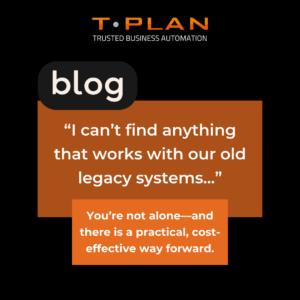Should you use power automate for RPA? A practical guide
Microsoft Power Automate is a widely recognised robotic process automation (RPA) tool, but is it the right solution for your business?
For organisations working within the Microsoft ecosystem, Power Automate offers low-code automation to streamline repetitive tasks, particularly those involving Office 365, Teams and SharePoint. However, when businesses require enterprise-scale automation, cross-platform compatibility or advanced test automation, Power Automate may not be the best choice. Understanding when to use Power Automate – and when to look elsewhere – can prevent costly implementation failures.
At T-Plan, we specialise in advanced automation solutions that go beyond Power Automate’s capabilities. In this guide, we’ll examine where Power Automate works well, its limitations and when a more flexible RPA solution is required.

Table of Contents
What is Power Automate?
Power Automate is Microsoft’s RPA and workflow automation platform, designed to simplify repetitive business processes. It allows users to automate tasks using pre-built connectors, cloud flows and UI-based automation.
Power Automate primarily serves businesses that:
- Operate within the Microsoft 365 ecosystem.
- Require basic process automation rather than complex, enterprise-grade RPA.
- Need a low-code solution for non-technical users.
Power Automate’s strengths
Power Automate has gained popularity due to its seamless integration with Microsoft products. Its key advantages include:
- Integration with Microsoft applications – Works effortlessly with Excel, Outlook, SharePoint and Dynamics 365.
- Low-code interface – Business users can create workflows with minimal technical expertise.
- Automation of everyday tasks – Ideal for data transfers, email notifications and approval workflows.
- Cloud-based automation – Supports both web-based and desktop processes via Power Automate Desktop.
While these features make Power Automate a good option for basic office automation, they also highlight its limitations. How well does it scale? Can it handle complex RPA needs? Let’s explore where Power Automate excels – and where it falls short.
When power automate works well
Power Automate is best suited for simple, rule-based automation that does not require significant customisation or scalability. Businesses that operate primarily in Microsoft 365 will find Power Automate useful for:
1.Basic office automation
Power Automate can effectively streamline repetitive, manual tasks, including:
- Copying and pasting data between Microsoft applications.
- Triggering automated email notifications based on business events.
- Generating reports and updating spreadsheets in Excel.
- Managing approval workflows for documents and invoices.
2. When your business runs on Microsoft ecosystem
For organisations heavily invested in Microsoft tools, Power Automate simplifies automation by providing:
- Pre-built connectors to integrate Microsoft applications with minimal configuration.
- Automation within Teams, Outlook and SharePoint without requiring custom development.
- Cloud-based execution that eliminates the need for local infrastructure.
3. Simple, rule-based workflows
Power Automate is effective for tasks that follow clear, predefined rules, such as:
- Scheduling email reminders and task notifications.
- Updating CRM records based on form submissions.
- Data synchronisation across Microsoft applications.
However, as businesses scale up their automation needs or require cross-platform compatibility, Power Automate’s limitations become apparent. Where does it struggle?
When Power Automate falls short
Despite its strengths, Power Automate has notable weaknesses that limit its suitability for complex automation.
If you need cross-platform automation
Power Automate is primarily Windows-based and lacks robust support for macOS, Linux or hybrid operating system environments. Businesses using a diverse technology stack may find it restrictive.
Additionally, while Power Automate provides API-based integration, it struggles with applications that lack modern connectors. This can create challenges for companies that use software outside the Microsoft ecosystem.
For legacy and back-office systems
Many older CRM, ERP and billing systems do not have APIs, making them difficult to automate using Power Automate. While UI-based automation is possible, it is often unreliable for outdated software, particularly when dealing with dynamic user interfaces.
T-Plan, by contrast, offers advanced UI-based automation that ensures compatibility with legacy applications, even when no APIs are available.
If scalability is a concern
Power Automate is not designed for high-volume, enterprise-wide automation. As workloads increase, businesses may experience:
- Performance bottlenecks when automating thousands of tasks simultaneously.
- Challenges in scaling RPA bots efficiently compared to dedicated automation platforms.
T-Plan’s enterprise-grade scalability ensures that automation processes remain efficient, even as demand increases.
For advanced test automation
Power Automate lacks dedicated testing capabilities, meaning:
- There is no built-in verification for automated workflows.
- Errors in automation may go undetected, leading to process failures.
- Businesses may experience unexpected automation breakdowns without clear diagnostic tools.
For organisations that require robust testing, T-Plan provides specialised RPA testing tools that validate automated workflows, ensuring reliability and accuracy.
Choosing the right RPA tool for your needs
While Power Automate serves well in specific use cases, businesses with more complex automation needs often find its limitations restrictive. If your organisation requires scalability, cross-platform compatibility or robust testing, it’s essential to explore alternative RPA solutions that can provide greater flexibility and efficiency.
Let’s compare Power Automate with other RPA solutions to determine which is the best fit for your business.
Power Automate vs. other RPA solutions
Feature | Power Automate | Alternative RPA Solutions |
OS Compatibility | Windows-only | Windows, Linux, macOS |
API Reliance | Requires connectors | Can automate legacy UI |
Scalability | Limited for large enterprises | Designed for high-volume automation |
Legacy System Support | Limited | Full UI-based automation |
Testing Capabilities | Minimal | Advanced test automation features |
When to use T-Plan instead
While alternative RPA solutions may address some of Power Automate’s limitations, they often introduce their own challenges – whether it’s complex setup, high licensing costs or a lack of built-in testing.
T-Plan offers a unique balance of flexibility, scalability and test automation that many other RPA tools lack. Unlike other solutions that focus solely on automation execution, T-Plan ensures automation is implemented, tested and optimised for long-term efficiency.
Cross-platform automation without restrictions
Many RPA solutions remain Windows-centric, making it difficult to automate processes across diverse IT environments. T-Plan is fully cross-platform, providing:
- Native compatibility with Windows, macOS and Linux without additional configurations.
- Seamless automation of web-based, desktop and virtualised applications, no matter the operating system.
- No reliance on third-party connectors or cloud-based execution, giving businesses full control over automation.
Reliable automation for legacy and complex applications
Power Automate and many alternative RPA tools struggle with legacy systems, particularly those that lack APIs. T-Plan is designed for:
- Legacy banking and finance applications that require UI-based automation.
- Older ERP, CRM and billing systems where API-driven automation is not possible.
- Proprietary software that cannot be easily integrated with mainstream RPA tools.
Scalability without excessive licensing costs
Enterprise RPA solutions often require expensive bot licences, making it costly to scale automation. T-Plan provides:
- A flexible licensing model that grows with your business needs.
- Efficient bot scaling for businesses handling high-volume automation.
- Cost-effective deployment options, ensuring maximum ROI.
Built-in test automation for superior reliability
Most RPA tools focus solely on process automation – but what happens when those automations fail? Unlike Power Automate and many competitors, T-Plan integrates testing within its automation framework, offering:
- End-to-end test automation to validate automation workflows before deployment.
- Proactive error detection to prevent data corruption or failed processes.
- Comprehensive reporting and debugging tools for greater automation stability.
Choosing the right RPA solution for your business
Selecting an RPA platform is about more than just automating tasks – it’s about ensuring reliability, efficiency, and scalability.
If your business needs:
- A cross-platform RPA tool that works on Windows, macOS and Linux.
- Automation for legacy and proprietary applications where APIs are unavailable.
- Enterprise-grade scalability without high licensing costs.
- Built-in test automation to ensure workflows remain reliable.
Then T-Plan is the ideal solution.
Conclusion:
Power Automate is a useful tool for businesses deeply embedded in Microsoft’s ecosystem, particularly for simple automation tasks. However, it is not designed for complex, scalable or cross-platform RPA.
For businesses requiring advanced test automation, reliable legacy system integration and cross-platform capabilities, T-Plan provides a more powerful and flexible solution.
Looking for an RPA solution that goes beyond Power Automate?
Discover how T-Plan can revolutionise your automation strategy.


